The Role of Red Ants in Traditional Medicine
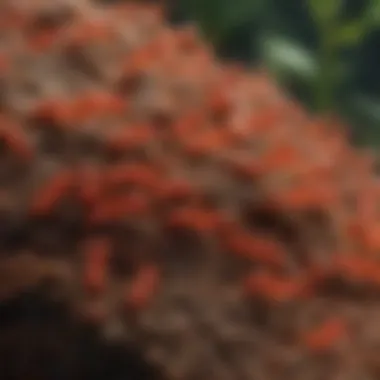
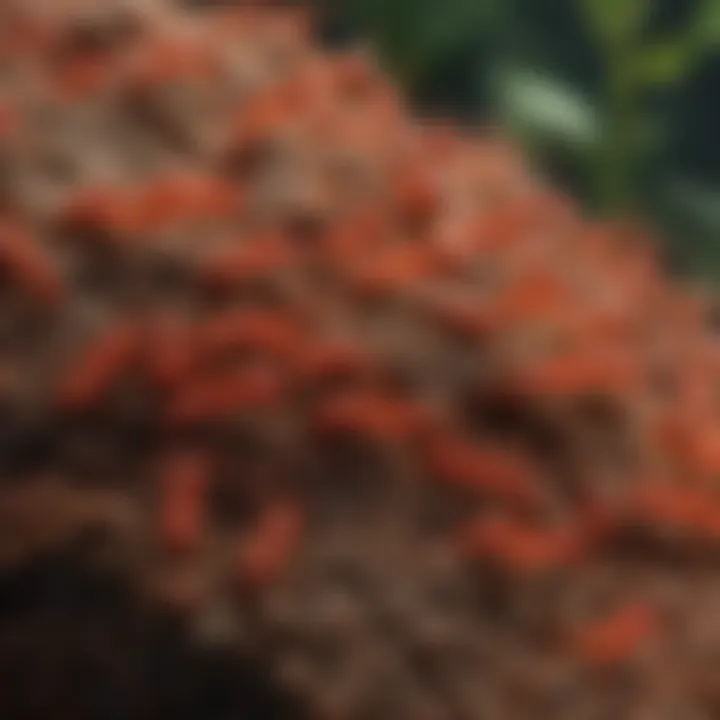
Intro
The significance of red ants in traditional medicine is a topic that deserves in-depth exploration. These insects have been part of cultural practices for centuries, serving various roles across different societies. This analysis aims to shed light on how red ants are perceived in healing traditions, revealing both their historical and contemporary applications. By studying the pharmacological properties attributed to these ants, we uncover potential health benefits as well as safety considerations.
One of the primary motivations for this examination is to understand the relevance of red ants in the realm of alternative medicine today. As modern society continually search for natural remedies, the wisdom ingrained in traditional practices becomes increasingly pertinent. Insights from historic uses inform current scientific inquiries, bridging ancient knowledge with contemporary health pursuits. Through this article, we will delve deeper into these intricate connections and discover the implications for future research and therapeutic applications.
Preface to Red Ant Medicine
The role of red ants in traditional medicine offers an intriguing realm of study. Understanding this topic allows us to explore not only the medicinal applications but also the cultural significance and historical context surrounding these small yet impactful creatures. Traditional medicine often relies on local fauna to provide remedies, and red ants have been a part of this practice for many cultures. As such, they hold a wealth of knowledge that could be beneficial in contemporary settings.
Historically, red ants have been used for various ailments. Their entire bodies, including the venom, have been seen as useful components in folk healing. The cultural practices that involve red ants highlight their significance beyond mere utility. They symbolize a connection between nature and health that many cultures still value today.
We will examine the specific species involved in these medicinal roles and the unique ways they are integrated into various healing practices. Furthermore, understanding red ants' role in traditional medicine opens discussions on their potential pharmacological benefits. This analysis aims to highlight the interface between time-honored practices and contemporary medical applications, particularly in alternative medicine.
Overview of Red Ant Species
Red ants, particularly the species known as Formica rufa and Solenopsis invicta, stand out for their medicinal applications. The former is commonly found in regions of Europe and is known for its aggressive behavior, while the latter, often referred to as the red imported fire ant, is prevalent in the southern United States. Both species exhibit unique properties that contribute to their use in traditional remedies.
These ants are often recognized for their chemical defenses, which can be harnessed in various ways. For instance, their venom contains alkaloids, which have been traditionally believed to aid in pain relief. Understanding the characteristics of these species is essential not only for their medicinal contributions but also for their biological behaviors that influence their use in traditional settings.
Cultural Significance in Traditional Medicine
The cultural significance of red ants in traditional medicine cannot be overstated. In numerous indigenous cultures, these insects are regarded as symbols of strength and resilience. The methods of using red ants in healing practices vary widely, influenced by local beliefs and practices.
Many communities celebrate the ant during specific rituals or as part of significant celebrations, emphasizing their connection to health and well-being. For instance, certain cultures employ red ants in treatments for wounds. The bites from these ants are believed to accelerate healing, showcasing how traditional medicine often intertwines ritualistic practices and herbalism for health improvement.
Moreover, red ants play a role in teaching ecological awareness. By incorporating natural elements into healing practices, cultures maintain a connection to their environment, which enhances the overall approach to health and wellness. This aspect emphasizes the importance of understanding red ants in a broader cultural framework, beyond just their medicinal uses.
Historical Context of Red Ant Usage
Understanding the historical context of red ant usage is crucial in unraveling its significance in traditional medicine. The practices and beliefs surrounding the use of red ants highlight a rich tapestry of cultural knowledge, ancient healing methodologies, and the evolution of medicinal practices through the ages. By exploring how societies have incorporated red ants into their healing rituals, we gain insight into their perceived value and the historical underpinnings that support their medicinal claims.
Ancient Practices and Beliefs
Red ants, revered in many cultures, have been part of ancient practices. Historically, various indigenous communities believed in the medicinal powers of red ants, using them for different ailments. These practices often stem from trial-and-error observations where red ants were noted for their effects on health. The sting of red ants, for instance, was sometimes viewed as a form of therapy. Some cultures regarded it as beneficial for conditions like arthritis due to the pain relief following the inflammation of the sting.
Communities have also attributed spiritual or symbolic meanings to red ants. They were seen as a connection between the earthly and the supernatural realms. Some tribes utilized red ants in rituals that aimed to appease deities or seek protection from illness. This perspective underscores a holistic approach to health, where physical treatment is intertwined with spiritual beliefs. By appreciating these ancient practices, we can better understand how these foundations have paved the way for contemporary views on red ant medicine.
Documentation through the Ages
The documentation of red ants in historical texts reveals how their medicinal use has been endorsed and evolved. Ancient manuscripts and traditional medicine treatises often reference the applications of red ants, providing a wealth of information. For example, traditional Chinese medicine includes references to the use of red ants in formulations aimed at enhancing overall health and vitality. Such documents often reflect observations of efficacy that have survived through generations.
In the modern era, anthropological studies have further illuminated these ancient practices. Researchers have recorded the methods of red ant use in various cultures, examining folklore, practices, and beliefs. Every written observation adds to the body of knowledge regarding red ants. Scholars note how traditional narratives and recipes inform contemporary understandings of their medicinal properties.
"The integration of ancient practices into current alternative medicine highlights the cyclical nature of healing knowledge, preserving wisdom that transcends time and culture."
Moreover, as globalization continues to influence medical practices, there is renewed interest in validating these ancestral uses through rigorous scientific research. This blend of historical documentation and modern inquiry is shaping the future of red ant medicine, establishing a bridge between the past and ongoing investigations into their pharmacological potential.
Pharmacological Properties of Red Ants
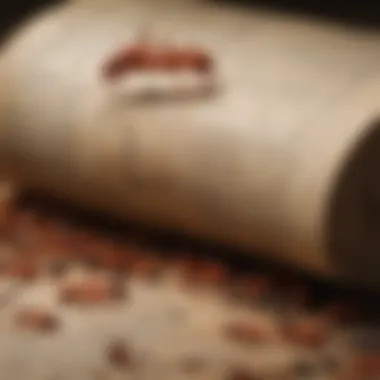

The pharmacological properties of red ants are crucial for understanding their role in traditional medicine. This section delves into the intricate chemical makeup of these insects, highlighting their potential therapeutic benefits. Red ants are not just simple creatures; they encompass a range of bioactive compounds that have sparked interest in both historical remedies and modern alternative medicine.
Chemical Composition Analysis
The chemical composition of red ants varies depending on the species and their environment. Studies show that red ants contain proteins, amino acids, and various bioactive compounds. These components are essential for their claimed health benefits. For instance, certain proteins in red ants act as enzymes that may have significant effects on inflammation and immune response. A detailed analysis of their chemical structure reveals the potential for developing new therapies based on these natural ingredients.
Additionally, some specific compounds found in red ants, such as formic acid, have been studied for their antibacterial properties. Identifying and isolating these compounds helps in understanding how they contribute to health benefits in folk medicine.
Potential Therapeutic Benefits
Potential therapeutic benefits of red ants span several health conditions. Below are the distinct areas where their properties have shown promise:
Anti-inflammatory Properties
Anti-inflammatory properties of red ants are particularly noteworthy. They contribute to reducing inflammation which is central to many chronic diseases. The key characteristic of these properties makes red ants a beneficial choice for individuals seeking natural remedies. Research indicates that compounds in red ants can inhibit certain inflammatory pathways in the body. This unique feature is important as it can provide alternative options for people with sensitivities to conventional anti-inflammatory medications.
However, it's essential to approach their use with caution due to the variability in individual responses to these compounds.
Antioxidant Effects
The antioxidant effects of red ants also merit discussion. Antioxidants play a critical role in protecting cells against oxidative stress. This stress can lead to various health issues, including cancer and heart disease. The key characteristic of these effects establishes why red ants are seen as a popular choice in traditional medicine. Their unique antioxidant compounds may help in neutralizing free radicals in the body.
However, while these effects are promising, more research is necessary to fully ascertain the extent of their benefits.
Antimicrobial Activity
Antimicrobial activity is another significant aspect of red ants. These insects possess natural defenses against pathogens, which can be advantageous in medicinal applications. The unique feature of this activity suggests that red ants may serve as a beneficial choice for treating infections. Studies have indicated that extracts from red ants demonstrate antimicrobial properties against various bacteria and fungi. Nevertheless, it is crucial to understand the implications and effectiveness of these properties through rigorous scientific inquiry.
The potential of red ants in pharmacology presents an exciting avenue for future natural health products, yet substantial evidence from clinical research is needed to confirm these benefits.
Understanding the pharmacological properties of red ants helps bridge traditional practices with modern scientific validation. This exploration suggests that red ants could play a pivotal role in advancing alternative medicinal therapies.
Contemporary Applications in Alternative Medicine
The incorporation of red ants into alternative medicine practices showcases a unique blend of ancient wisdom and modern therapeutic needs. This section delves into how various cultures have adopted red ants in medicinal contexts and the growing interest in their potential applications across contemporary medicine. As societies move towards holistic healing methods, the significance of understanding these applications deepens, especially in a world facing increasing health challenges.
Red Ants in Folk Remedies
Red ants have a rich history as a component in folk remedies across different cultures. In rural communities, the use of these insects often stems from longstanding traditions. These medicines typically focus on treating common ailments. For example, crushed red ants are sometimes used for their purported anti-inflammatory properties. This practice highlights a key trait of folk medicine: the direct utilization of readily available local resources.
- Folk remedy examples include:
- Topical salves made by mixing crushed ants with herbal pastes to reduce swelling and pain.
- Infusions or decoctions prepared from red ants aimed at boosting immunity.
Despite anecdotal claims of their benefits, scientific studies on these folk remedies are limited. However, the rich tradition around red ants suggests there may be valid therapeutic values waiting to be studied more thoroughly. It is crucial to document these practices, as they reflect a deep understanding of local biodiversity and medicinal properties.
Integration into Modern Treatments
With the rise of interest in alternative medicine, the integration of red ants is slowly taking form. Now, researchers are beginning to explore specific compounds found in red ants that could contribute to modern medicine. The trend points towards a systematic extraction of active ingredients for various applications.
Current trends involve:
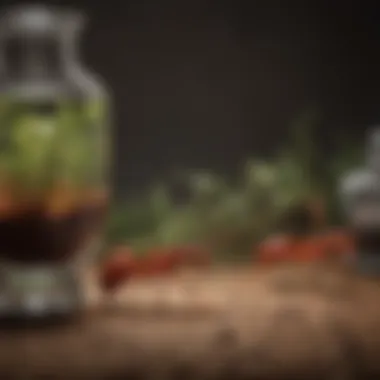
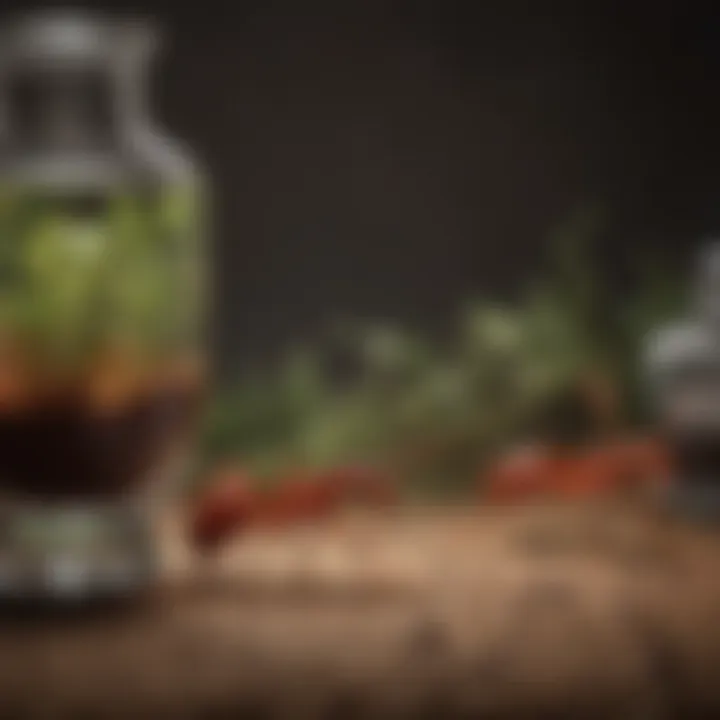
- Phytochemical analysis that identifies the bioactive compounds in red ants and their potential implications in the treatment of chronic diseases.
- Developing supplements using red ant extracts, focusing on their antioxidant and antimicrobial properties.
These integrations must be approached with caution. While there are promising leads, there are also significant challenges regarding dosage, standardization, and understanding interactions with conventional medications. This highlights the need for rigorous clinical trials to ensure efficacy and safety.
"The journey from traditional practices to scientifically validated treatments is complex, yet essential in assessing the full potential of red ants in medicine."
Preparation and Administration
Preparation and administration of red ants in traditional medicine are crucial for effectively harnessing their potential benefits. Knowing how to prepare red ants properly ensures that their medicinal properties are fully extracted. Furthermore, understanding how to administer these preparations makes it easier for practitioners to incorporate them into treatment regimens. The methods of preparation can influence the efficacy, safety, and bioavailability of the active components in red ants.
Common Preparation Methods
Infusions
Infusions are a popular method for preparing red ants in traditional systems. This technique involves steeping red ants in hot water for a specific duration. One key characteristic of infusions is their ability to extract compounds effectively into a liquid form, making it easier to consume. Infusions are beneficial because they provide a digestible form of the active ingredients while retaining flavor and aroma. Furthermore, they are relatively easy to prepare, requiring minimal equipment. However, the unique feature of this method is the variability in temperature and steeping time, which can impact the extraction quality and potency of the final product.
Powders
The preparation of red ants in powder form is another widely recognized method. This involves drying the ants and then grinding them into a fine powder. Powders are often chosen for their convenience and the broad spectrum of applications they offer. They can be easily added to food or beverages, enabling a seamless incorporation into daily diets. The unique feature of powders is their stability and longer shelf life compared to other forms. However, one downside is that they may require precise dosage control to avoid overconsumption or ineffective treatment.
Tinctures
Tinctures represent a concentrated preparation of red ants, where alcohol or glycerin is used as a solvent to extract the components. This method is notable for its high potency, as tinctures preserve a wide range of active substances that might be lost in other preparations. They are often favored for their extended shelf life and effectiveness in small doses. One distinct advantage of tinctures is their rapid absorption into the bloodstream, enabling faster effects. Nonetheless, their alcohol content can deter some individuals from use, particularly those who prefer non-alcoholic options or are sensitive to alcohol.
Dosage and Administration Guidelines
Proper dosage is vital to maximize the therapeutic benefits of red ants. Dosage may vary based on the specific preparation method used, individual health conditions, and objectives of treatment. Consultation with a knowledgeable healthcare provider is recommended for tailored dosage advice to ensure effective and safe use.
Safety Considerations and Risks
The use of red ants in traditional medicine presents several safety considerations and potential risks. These aspects are essential to understand before incorporating red ant products into treatment plans. While red ants are noted for their medicinal properties, the lack of comprehensive research on their safety complicates their use. Understanding the associated risks can guide both practitioners and patients toward safer practices.
Potential Allergic Reactions
Allergic reactions to red ants can vary in severity, with symptoms ranging from mild skin irritations to severe reactions like anaphylaxis. Individuals with a history of allergies to insects may be at increased risk. Some common allergic responses include:
- Hives or rashes: These may appear on the skin shortly after contact with red ants.
- Swelling: Swelling of the face, lips, or throat is a more severe reaction that can indicate anaphylaxis.
- Difficulty breathing: This can occur if the airways swell, leading to respiratory complications.
It is advisable for individuals to consult healthcare professionals prior to using red ant products, especially if they have known allergies. Performing a preliminary patch test can also help to identify potential allergic sensitivities.
Interactions with Conventional Medications
Red ants may interact with various conventional medications, affecting their efficacy and safety. Because red ant products contain active compounds, it is crucial to understand how they may influence other treatments. Some considerations include:
- Blood thinners: Ants contain substances that can affect blood coagulation. Using them concurrently with anticoagulants like warfarin may increase bleeding risks.
- Immunosuppressants: Red ant components may influence immune responses, potentially undermining the effectiveness of immunosuppressive therapies.
- Antibiotics: While some properties of red ants exhibit antimicrobial effects, they may also interact with certain antibiotics, leading to reduced effectiveness.
Patients should always disclose their use of red ant treatments to healthcare providers to ensure safe and effective disease management. Regular monitoring and communication can mitigate risks associated with medication interactions.
Ethical Considerations in Harvesting Red Ants
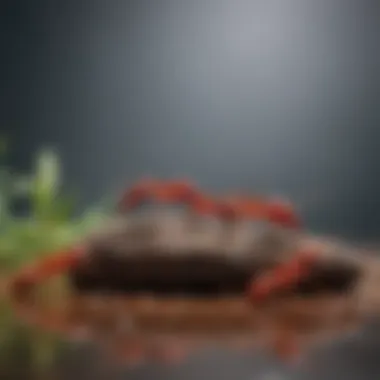
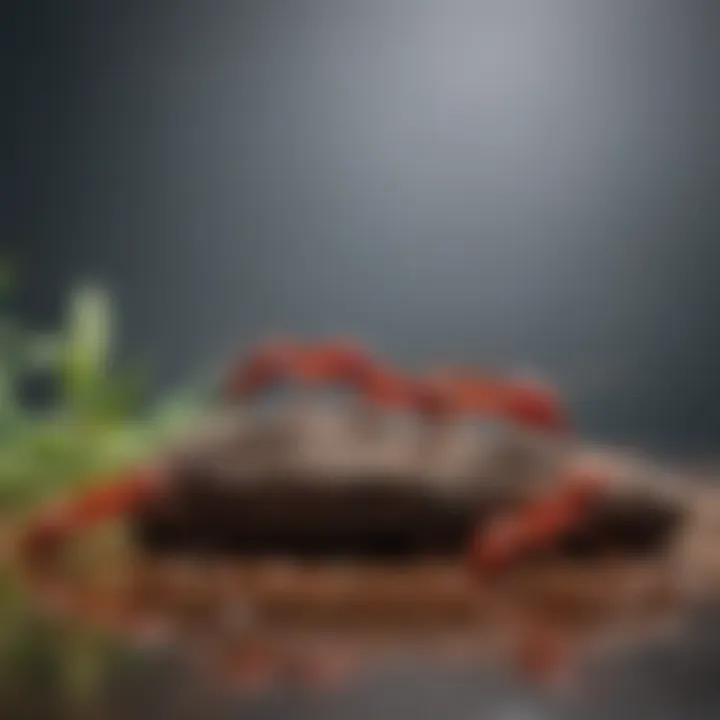
The harvesting of red ants for traditional medicine raises vital ethical questions. These considerations are important because they affect biodiversity, cultural practices, and the sustainability of traditional medicine. Ethical practices ensure that the traditions carrying indigenous knowledge do not lead to environmental degradation. Understanding these elements lays a foundation for responsible use and conservation of this resource.
Sustainability Concerns
Sustainability is a key topic when discussing ethical harvesting of red ants. The demand for red ants in traditional medicine can lead to over-exploitation. If populations decline due to excessive harvesting, it has several negative consequences, including the loss of local biodiversity and the disruption of ecosystem dynamics. To prevent such outcomes, several strategies can be employed:
- Controlled Harvesting: Implement methods that limit the quantity of red ants collected. This approach includes setting quotas based on population surveys.
- Habitat Conservation: Protect the natural habitats where red ants thrive. Ensuring these ecosystems remain intact supports the ants’ populations and their roles in traditional practices.
- Community Education: Educate local communities about sustainable practices and the ecological significance of red ants and their habitats.
Efforts to foster sustainability in harvesting can not only preserve the species but also strengthen local communities’ reliance on red ants as a part of their cultural heritage. But the need for well-informed strategies cannot be overstated.
Regulation of Use
Regulation plays a crucial role in the ethical harvesting of red ants. Creating frameworks that govern how red ants are collected helps ensure that practices are sustainable and fair. Regulations could include:
- Licensing Systems: Require individuals or organizations that harvest red ants to obtain permits, helping to monitor and control the quantities collected.
- Regular Assessments: Conduct assessments to monitor red ant populations in various regions. Regular monitoring can inform regulatory bodies about the health of populations.
- Cultural Sensitivity: Regulations should respect the traditional practices of local communities. Authorities must engage with these communities to create guidelines that honor cultural significance while prioritizing sustainability.
While regulations are crucial, community involvement remains pivotal. Collaboration between policymakers and local practitioners can lead to more effective outcomes. When ethical considerations are prioritized, it ensures both the preservation of species and the traditions that rely on them.
Ethical harvesting of red ants is not merely a guideline but a necessity for maintaining the delicate balance between traditional medicine and conservation.
Scientific Research and Future Directions
The role of red ants in traditional medicine encompasses a wide array of uses and applications that merit extensive scientific exploration. Current research highlights not only the cultural significance but also the pharmacological elements of red ants, which have been underappreciated. Investigating these aspects may unlock new potentials for medical treatments that leverage both the historical context and modern scientific methodologies. As the understanding of sustainable practices evolves, the prioritization of red ants in research agendas can yield insights into their benefits and applications in alternative medicine.
Current Studies on Red Ants
Research has been focussing on the biological and chemical properties of red ants. Scientific investigations aim to characterize their active compounds and assess their therapeutic effects. For instance, studies have shown that certain species possess antimicrobial properties that might be harnessed for treating infections. These findings reflect an increasing recognition of red ants as a source of valuable bioactive compounds. Moreover, tracking traditional uses in conjunction with scientific validation could enhance credibility among practitioners of alternative medicine.
Potential Areas for Exploration
Pharmacognosy of Ant Products
Pharmacognosy deals with the study of medicines derived from natural sources. Within red ants, this branch of study holds promise as it seeks to isolate and delineate the chemical constituents responsible for their medicinal properties. A key characteristic of pharmacognosy is its ability to bridge traditional knowledge with scientific rigor. By analyzing the unique biochemical markers found in red ant species, researchers can identify specific pharmacological activities. This dual approach serves to validate folk remedies while also providing a systematic methodology for further exploration. One advantage of focusing on pharmacognosy is its potential to enhance the quality control of red ant preparations, ensuring that therapeutic applications are both safe and effective. However, challenges remain, particularly in the standardization of extraction processes and the variability of active compounds across different ant species.
Clinical Trials for Medicinal Use
Clinical trials offer a structured framework for evaluating the effectiveness and safety of treatments. The exploration of red ants in this context could lead to significant advancements in understanding how these insects can be integrated into therapeutic regimens. A key feature of clinical trials is their systematic evaluation of dosage, efficacy, and potential side effects. This makes them a beneficial avenue for investigating the role of red ants in modern medicine.
The unique aspect of conducting clinical trials for red ant products involves establishing a clear protocol that aligns traditional applications with scientific inquiry. While trials can unveil the medicinal value of substances, they also present challenges such as ethical considerations and the need for comprehensive regulatory frameworks.
"The exploration of red ants within clinical contexts should focus on stringent guidelines to ensure safety and efficacy."
The End
The conclusion serves a vital role in consolidating the insights gathered throughout this article, drawing attention to the intricate relationship between red ants and traditional medicine. The importance of this examination cannot be overstated. It encapsulates the myriad ways in which a seemingly simple insect has impacted cultural practices and medicinal applications. Red ants, often overlooked, hold considerable value in alternative healing frameworks. This understanding enables a reevaluation of natural resources in health care.
Summary of Key Insights
Several key insights emerge when analyzing the role of red ants in traditional medicine. First, their historical usage reveals a long-standing belief in their therapeutic properties. Traditional practices often include preparations from red ants, emphasizing their perceived benefits. Second, the pharmacological properties of red ants, including anti-inflammatory, antioxidant, and antimicrobial effects, are backed by various scientific studies. These findings indicate a need for further research in clinical applications. Lastly, the safety considerations and ethical implications regarding the harvesting of red ants highlight vital points for responsible use and sustainability.
Final Thoughts on Integration with Modern Medicine
The integration of red ants into modern therapeutic contexts presents an intriguing opportunity. As traditional medicine intersects increasingly with modern health practices, exploring the utility of red ants may lead to innovative treatment modalities. The push for natural remedies in contemporary medicine aligns with a broader movement toward holistic health approaches. Acknowledging the potential of red ants encourages a broader acceptance within scientific circles. Potential clinical trials could further validate their efficacy, ensuring that these traditional insights contribute to future medical landscapes in a manner that aligns with both efficacy and ethical sourcing of resources.
The relevance of red ants in medicinal practices underscores the importance of acknowledging cultural insights while fostering scientific exploration.
Engaging with the past and anticipating future applications allows both traditional and modern practices to coexist, potentially enhancing patient care and outcomes in the field.



